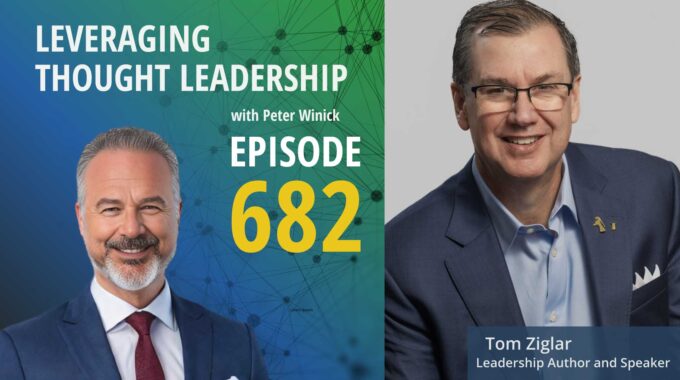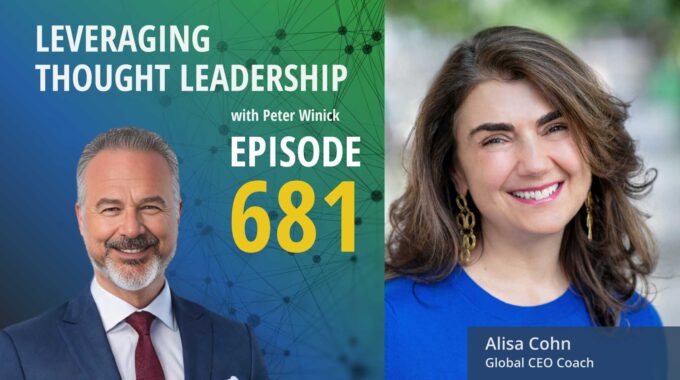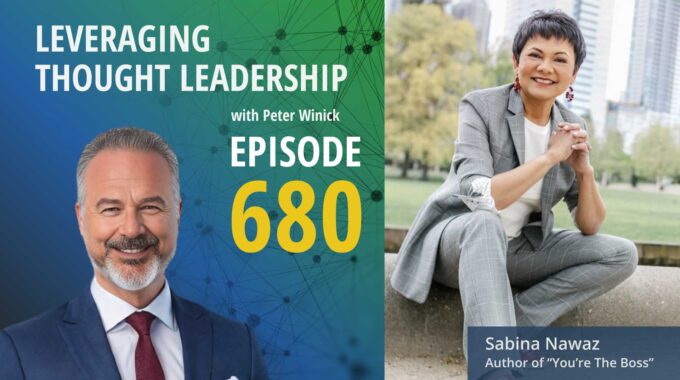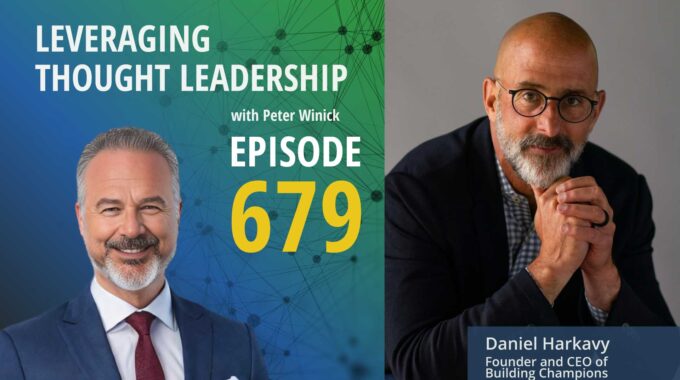How AI, Programs, and Trust Turn Ideas into a Life-Changing Business This episode explores how…
Transitioning from Broadcasting to Thought Leadership | Lynn Smith
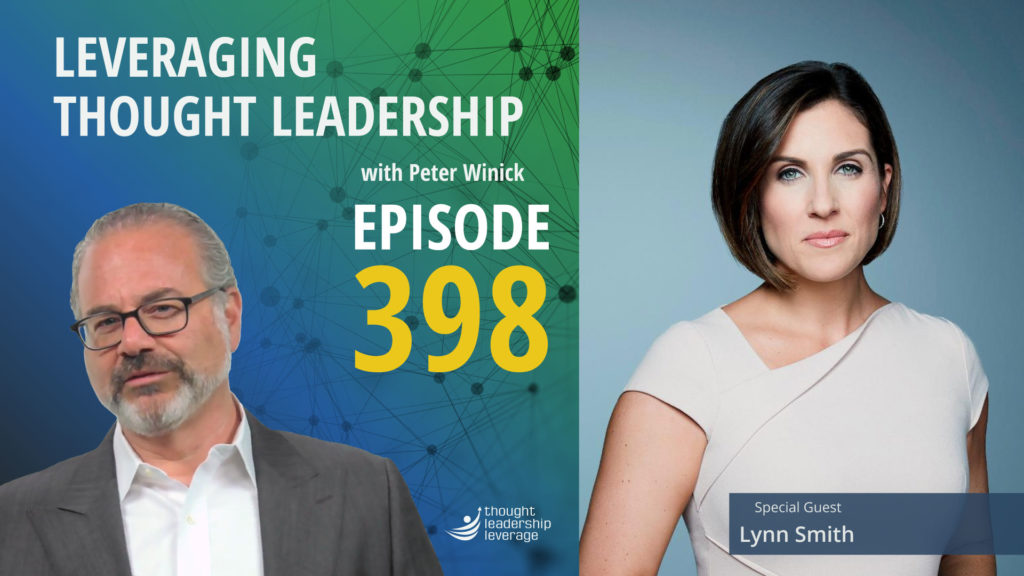
Using the lessons of broadcast journalism to enhance your thought leadership.
An interview with Lynn Smith about taking experience in broadcast television and using it in thought leadership. about taking experience in broadcast television and using it in thought leadership.
A short video has 3-5 seconds to get the viewers’ attention, and 30 seconds to get them to stay.
Are you up the challenge?
Creating videos, catching attention, and the ability to speak well on camera are acquired skills – and today’s guest, Lynn Smith, knows how to master them all. Lynn is a journalist and former news anchor with NBC News, MSNBC, and CNN Headline News. With 15 years of experience in headline news, Lynn knows how to take complex stories and boil them down to a single, strong core. Lynn is now using that experience as Founder and CEO of Rylan Media, helping clients tackle their biggest branding and communication challenges.
We start by asking Lynn about her insights on taking a complicated story and communicating it to the audience in a clear, succinct manner. Lynn explains how she breaks it down to the headline to grab attention, fills out the story with compelling details, and finally, adds “the chill factor” to leave her audience with a thoughtful takeaway.
While many thought leaders can command attention and be charismatic on stage and in person, video meetings, online conferences, and video content creation have changed the game. Lynn shares tips on ways to overcome your awkwardness and connect with the lens in the same way you would a close friend. Her years of experience provide many tips and clear insight that you simply won’t want to miss!
If you want to create compelling videos that get a ton of hits, this episode is for you!
Three Key Takeaways:
- Thought leadership videos need to be short. You must connect with the audience in the first five seconds.
- Many people experience Zoom fatigue, but we should also embrace the change that has facilitated simple global communication.
- Budding thought leaders need to be resilient and keep going. Failure is just a lesson, a minor obstacle on the path to success.
If you need a strategy to bring your thought leadership to market, Thought Leadership Leverage can assist you! Contact us for more information. In addition, we can help you implement marketing, research, and sales. Let us help you so you can devote yourself to what you do best.
Transcript
Peter Winick And welcome, welcome, welcome. This is Peter Winick. I’m the founder and CEO at Thought Leadership Leverage and you’re joining us on the podcast, which is Leveraging Thought Leadership today. My guest is Lynn Smith. Lynn has had an amazing career in broadcasting, including being at NBC News, MSNBC, CNN Headline News, The Today Show and many others. She is a storyteller at heart and now has a company called Rhineland Media, which helps people effectively communicate.
Peter Winick So, welcome aboard, Lynn. How are you?
Lynn Smith Thank you. I’m wonderful. I love that phrase “storyteller at heart.” It could not be more true.
Peter Winick There we go. So you went from being sort of a journalist, a storyteller on air, to now having your own sort of slice of thought leadership, if you will, and you’re deploying that to help others effectively communicate. So talk about that transition from sort of in front of the camera to the world of fall leadership.
Lynn Smith Yeah. I mean, I spent 15 years on the anchor desk. And over time, as I’m sure many people have seen the, the world of journalism has changed dramatically. And I really wanted to continue the art of storytelling, where the train for journalism was leaving the station in a different direction than I wanted to go. And so I knew if I was going to make an impact in this work, I would be going directly to those who have a great story to tell. They’re just not sure how to put the pieces together. And once I brought in that expertise of being able to drill down a very complex and complicated story into a minute 30. Right. That’s what we do for news stories is we really. Yeah. Once I saw how those kinds of skills applied to other thought leaders, it gave me a great sense of fulfillment to become more of a communicator to these thought leaders rather than a communicator into the lens to the viewers at home.
Peter Winick Interesting. So in the business world, you know, if we if we were to sort of take it that way, there’s lots of people out there selling, communicating, leading, managing whatever and the lack of a storytelling style, if you will, if that’s a thing, leads to a lot of boredom, a lot of ineffectiveness, a lot of people being tortured through meetings, looking at PowerPoints with six point type, etc. And I think it’s that art of whatever it is you’re trying to do, whether it’s with your team, whether it’s managed, whether to present a solution to a potential client. If you can wrap that in a story, I don’t know if you can always do in a minute 30, but if you can wrap it, at least have a story underneath it. It gives you a structure, gives you a framework, and it connects with people emotionally, not just in a rational, logical sense. Is that part of the sort of the work you do?
Lynn Smith Yeah. And it’s not even you can’t even have an effective conversion from potential client to client if you have a great story when you’re not hooking them within 30 seconds. So I often say you have 5 seconds to get someone to like you. You have 30 seconds to get them to trust you. So whatever you’re coming out of the gate with within those first 5 seconds, you’ve got to be able to get something that they’re not going to swipe up. Think of it as tick tock, tick tock. If you haven’t hooked someone with 3 to 5 seconds, they’re just swiping. They’re going. The same is true for the boardroom. For a zoom call, for an investor call, that first 30 seconds is so key. So first we start on that piece of the puzzle. We’re getting people hooked within 30 seconds. And I also teach people how to talk in soundbites in that regard. Tell me why I should care. Put that in headline form and that is the first thing out of your mouth. After that, you give me the meat of your story, which is what we help craft. And then you end on the chill factor, something that’s really memorable. It’s rethinking the elevator pitch so you can have a great story, but if you haven’t hooked people in the beginning, it doesn’t matter. And that’s what we really focus on now.
Peter Winick So I think a lot of that can be done by asking yourself before the, whatever, is right, whether it’s a one on one with someone or a team meeting or whatever, like what’s the hook here? What am I trying to get across and what’s the best way to get it across? So I want to sort of go in a little bit of a different direction. So as a you know, as a direct result and it was happening before, but clearly as a direct result of COVID, it feels like we’re all sort of broadcasting all day. I mean, I can speak for myself. I’m on whatever, 12 or 15 Zoom calls a day and had always mastered two things the art of the conference call, including when to use mute and all that, and then the art of the in-person in terms of, you know, where’s the power seat and you know, how to how to stage a room and all that. And it took a lot of us a long time to sort of get comfortable enough to be in broadcast mode because, like, you know, you and I are now recording this on Zoom. So there’s two little boxes on the screen. It kind of doesn’t look all that different than a lot of CNN or Fox or whatever what we see today. So what are the things people need to know in order to be. Able to take advantage of this medium because I happen to like it. But it does take a while to sort of develop these new muscles and capabilities because.
Lynn Smith It’s not natural. When we are or effective communicators in business, we’re sitting in a boardroom and we’re looking each other in the eye and we are taking cues from whoever we’re talking to. We’re looking at facial expressions for validation, we’re looking at body language and we’re silently communicating. When you take that out and you’re having to do that all through a tiny little black lens. It is a completely different skill set. But the reality is that video is the new boardroom. This is the only option we’re going to have either 100% virtual or a hybrid mix of virtual. So if you don’t nail this, then you are just going to become obsolete. This is like being able to operate your business without using the Internet. So, you know, one of the things that I often talk about with people in an effective way to connect to the camera because we want to start that mindset of you’re looking into that lens and you’re connecting to it. So when you’re looking into it, I often describe you need to be visualizing your MTT. This is your most trusted person. So you’re not looking into a black lens. You truly are looking at a face that you can visualize and you’re talking to them just like you would in any other setting. What would you say to somebody at a cocktail party that’s engaging? What would you say to them in the boardroom? You’re visualizing it. That takes a little bit of that coldness that comes from the camera that that we can’t fix these days. And we also are in this awkward place where if you’re not showing up, if you don’t look the part, you know, you can’t see my set right now because this is all audio. But if you don’t have a nice presentable at home set, which, Peter you have, which I love, but if you aren’t doing that, you know, this isn’t March 2020, there’s no longer the excuse to look like you’re coming from your closet. You need to be able to show up the same way you would in a conference room as you would.
Peter Winick I think that’s dogs barking. Yeah. No, and I think that’s key. And it doesn’t you know, it’s not expensive to do, right? It’s not you know, ten years ago you needed a ton of money for an at home studio. I mean, you can go on Amazon to put something together for 100 bucks and minutes today, right? Like it’s not a big deal and you don’t need to be all that tech savvy. I want to get your take on there’s a lot of conversation right now around zoom fatigue and different companies having different etiquette. I look at it and say I kind of I kind of call B.S. on it from the perspective of yes. Is it exhausting to be on Zoom all day? Yeah, but it’s exhausting to put in a hard day’s work on a conference call face to face meeting. It should be tiring. And I think that some of the zoom fatigue is we’re trying to move our bad behaviors from a conference call where if I’m just sort of a level participant, I can have the audio on and doing my emails and doing other things and whatever by being on camera, it forces you to be there, right? I can’t just take up my phone now and check my emails. I can’t do other things. And I think we’re not used to doing one thing at a time, and I think we’ve had to resort of rework our brains a little bit. Any thoughts on that?
Lynn Smith Well, I mean, I think that zoom fatigue is real because there’s actual science behind it. So when you are in person with someone, your brain’s operating in real time. When you’re on video, there’s like a millisecond of a delay when you’re looking at someone. So your brain is actually trying to work to understand what the person’s saying in ways that it wouldn’t in person. I mean, look at what’s really fascinating, because in the beginning of the pandemic, I was just exhausted at the end of the day, but I wasn’t exhausted when I was in the office. And that’s a real thing. Your brain is just working harder. So, yes, fatigue is real. But if you adjust your mindset to embrace with this new world of video has opened up as an opportunity. So are you able to close so many more client meetings and contracts and business? Because you can be in Hong Kong this morning and then New York in the afternoon. And, you know, that’s a real exciting thing about the world that we’re living in right now. So, yes, not everything’s perfect, but it’s opening up an entire new world of business. And now we just need to challenge ourselves to be really good at it.
Peter Winick Yeah. And I think another piece that’s sort of interesting and maybe counterintuitive and I read a bit on this is that there are a lot of introverts that are more comfortable in a Zoom situation as opposed to a physical meeting, right? Where someone is doing the physical presence or whatever, the pieces that maybe it’s because they’re in their own home office or they’re comfortable or whatever. But we’ve neutralized a little bit of the, you know, just the power of the charismatic, which doesn’t being the most charismatic is not synonymous with being the smartest or having the most to say or the best thing. That’s it. So any thoughts on that?
Lynn Smith Oh, goodness. You are exposing my Achilles heel. So, I always. Especially in my training, I talk about addressing your weaknesses. My weakness, which people are so shocked to learn, is public speaking. I connect to a camera because it is my crutch. It is my trained eye and emotional link that I have built over 15 years of being an anchor. The same does not apply in a room of 8000 people, and it’s very true of what you’re saying. Introvert people are shocked to learn. I am more introverted than you would expect. Why?
Peter Winick For a minute, though. Yes. Just stay there for a minute and I want to get back to it. I have dozens of clients that I won’t name them that are, you know, very well-known, world-renowned keynote speakers, where you tell them, hey, literally in 5 minutes you get to get on the stage in front of 3000 people. Nothing like. Yeah. Okay, let’s rock and roll. Tell them they’ve got to go to a cocktail party with 12, you know, with 25 people or an intimate dinner with ten or 12. And it’s not going to happen. So, I think people have this selective comfort zone, right, that you would think it’s odd to have be comfortable in front of 8000 people. Many, many would be terrified for your world, to be, petrified. And that little red light goes on and Brazilians watching you. So I think it’s not.
Lynn Smith A camera with ared light and zillions of people. And I am on like no one else in me, a room full of zillions of people. And I tell people that they cannot be afraid to talk about what it is that scares them when they’re looking into the lens. You can’t overcome that. And even I say we turn it into one of your superpowers, like we take what it is that scares you and makes it an asset to you. And when you talk about it and you address it, that’s how you break down this wall that’s preventing you from overcoming it. And so I think it is, you know, because exactly what you’re talking about, this is not uncommon. In fact, it’s the majority of people have a strength and a weakness. And if your weakness is looking into that lens, then it’s really more a matter of how are you going to address that? How are you going to make sure that you do show up? Because if you don’t, you will sort of be crushed by the combination of.
Peter Winick If you’re enjoying this episode of Leveraging Thought Leadership, please make sure to subscribe. If you’d like to help spread the word about our podcast, please leave us a review and share it with your friends. We’re available on Apple Podcasts and on all major listening apps as well as at ThoughtLeadershipLeverage.com forward slash podcasts.
Peter Winick So let’s, let’s apply your thought leadership to the world of thought leaders. Let’s sort of put your chocolate, my peanut butter together. If they’re still doing that on the Reese’s commercial. I see lots and lots of world renowned, amazing, talented, gifted people that have real trouble effectively communicating. Right. So, number one, maybe they came up in the world of academia and they’ve written for academic journals and you’re going to read those and you’re like, Oh my God, this isn’t even the same English I’ve used in any way, shape or form. Maybe they’re more introverted and they’re comfortable writing, and the written word is better. The spoken word is not there. How do you coach some of those folks along? Because I think it’s incredibly limiting when someone isn’t an effective communicator, particularly as a thought leader, or if they can only do it in a book because you can’t put out a book every 5 minutes. It’s a monumental task.
Lynn Smith Now, and it’s so important right now as a thought leader to be able to master that 32nd from like to trust. Right. So let me give you an example of one of my clients; I work with oncologists with the Cancer Institute. And you haven’t lived until you have gotten an oncologist to be able to come out of their shell and shine within 30 seconds because they are the ultimate thought leader. They think through every single problem. They will take as much time as possible to articulate the importance of research and the detail of diagnosis. But we’re talking about television here or video, you take it, your investor call or your.
Peter Winick Well, but stay there for a minute. That makes perfect sense for a doctor in the context of delivering medicine. Right. I wouldn’t want a doctor that that’s you know, I don’t know what Dr. Oz is bedside manner. And he’s pretty good on TV. I don’t know.
Lynn Smith We don’t want them to change their bedside manner. We want them to change their video delivery of that. So, in a media appearance, what we train them to do is how do you get all of that information and drill it down to a 35 to 45 second soundbite? And what we have done is that why we should care? Put it in headline form. It’s the first thing out of your mouth, the meat of what you want to do as a takeaway, which is the valuable information for the viewer and ending on that chill factor, which is like that thought that, oh wow. Like hits you over the head. It’s memorable. That’s what the chill factor is when you communicate in those types. Of walls, I say around a soundbite, you have some sort of road map to follow where you’re talking to a patient. You’re going to take all the time that you need. When you’re talking to a conference of colleagues, you’re going to take all the time you need to be that meticulous thought leader who is great, smart, wise, all of those things. When you only have 30 seconds to get people’s attention, we’ve got to just adjust the model.
Peter Winick I love the model because I’m a big fan of systems, processes, models, methodologies, right? So there’s one type of expert that just does stuff because they know how to do stuff and they’ve been doing it forever and can’t break it down into the atomic pieces of the Lego pieces to put it back together. So, you know, I love your framework because you go, Oh my God, I only have 90 seconds. So you give me a time limit and then you give me the other variables are going to end up in short back and you’re like, Oh my God, that’s overwhelming. It actually makes it easier. It’s sort of like calling in the lines, if you will.
Lynn Smith It gives you boundaries where I also encourage people to pick 3 to 5 takeaways. So, if you’re going on an appearance and all of these things apply to any type of video that you’re going on to a podcast or a town hall, make 3 to 5 takeaways because people can’t really handle more than five. Three is a sweet spot, but if you have two extras, three is always going to be a sweet spot. Make sure you establish what those 3 to 5 are. That also sets the boundaries. You’re not rambling on. You’re not repeating yourself. I encourage people to say, Hard, stop when you’ve made your point hard, stop. Don’t repeat it over and over again, even though you want people to understand it more. So I’ll say to you right now. Stop. I know my sound bite one.
Peter Winick I think there’s that less is more piece because you always feel like you want to give the audience whatever that might be. It could be one. It could be thousands. So much of what you’ve got, especially when they’re in the zone and they’re taking it in and they like to work and you want to share as much as you can. If you give me more, it’s less attractive. And I think that takes a while for people to process go, you know, three’s the magic number, right? Like, you know, I’m like, I can remember what I had for breakfast. If you tried to hit me in a couple of minutes with a long list of 13 things in one of your out, the other done. Have no idea what happened. Give me two or three things later when I’m going to take a walk or something. It’s going to rattle around in my head. It’s going to pop up when I’m in the shower. I can you know; I can digest it. I think that that’s another piece is that less is more piece is important.
Lynn Smith Absolutely. And everyone wants to sound smart. So, they think more is more. And it’s the exact opposite, as you say.
Peter Winick So as we start to wrap a little anything you want to share about your journey as a thought leader and where you are, where you’re going, what it’s been like, I think in front of people.
Lynn Smith Well, I keep talking about it because I have learned and this is a big part of my messaging, the importance of resiliency, especially as a thought leader and especially as an entrepreneur. I spent 20 years, 15 years as an anchor, but 20 years in the corporate world. And there’s a lot of safety and security and in the corporate world, right? We’ve got our contracts, we’ve got our health insurance, we’ve got the touch box, the paycheck, all the things, all the things that make us feel so comfortable. But what I encourage people to remember is if that’s not bringing you joy, therefore you are not making an impact through that work. Therefore, you are not finding real fulfillment, then it’s really not that secure. There are layoffs, you know, restructuring where your job all of a sudden disappears. And then you look back and you say, I just spent 25 years dedicating my life to a company and now I’m forced to start from scratch and figure out what to do if there is anything. And it’s the whole great awakening slash great resignation, right? People are realizing that they need to be making the impact they want to become. Those thought leaders and many people listening right now may have done that. And they’re new in this thought leader space. And I would just continue to lean on the concept of the just keep going. That is that is really something I call it. My mantra of entrepreneurship is you are just pushing through whatever it is that the challenges because everywhere around the next corner is a potential success. And I’ve come to enjoy failure because it means I’m one step closer to success and I’ve found great success in my business through this philosophy and mentality. So I just say to other thought leaders to continue that journey of your impacts, because that’s what thought leaders do. They make an impact, and that’s the purpose.
Peter Winick What I love. And I would add that there is that false security of stability right now. I think what happens is I’m not a corporate guy either, right? In that you have this false security of stability, which is a total fallacy. People get laid off all the time. You get a boss that makes your life miserable, blah, blah, blah, blah, blah. And the longer you’ve been at one place, it’s easy to get a bit stale without knowing it. And I think one of the superpowers of being an entrepreneur is you can’t afford to be scale, right? You’ve got to know. It doesn’t matter what you think. You’re constantly listening to the market, modifying, tweaking, pivoting, whatever. And yeah, the stability is what it is.
Lynn Smith But you just like you say, I mean, the false narrative, it is more so what I hear from people. I wish I could have done what you did. I’m just too scared. And so it’s not that they they’re using the excuse of stability. It’s more the fear of what is the unknown. And I often say if it doesn’t scare you, you shouldn’t be doing it. Scary is the best. But I have something on my website at Lynn Smith to. At the top where you can take a superpower quiz, you can find out what it is that storyline you are living out. Are you an educator, a champion and undiscovered star? What storyline are you living out? And then how do you unleash that to evoke impact? And if you are in that place where you just aren’t sure what your story is, it’s a really great place to start to develop that story.
Peter Winick Fantastic. Well, this has been phenomenal. Appreciate your time. Thanks. Thanks for sharing that. I appreciate it.
Lynn Smith And great to be with you.
Peter Winick To learn more about Thought Leadership Leverage, please visit our website at ThoughtLeadershipLeverage.com to reach me directly. Feel free to email me at Peter at ThoughtLeadershipLeverage.com and please subscribe to Leveraging Thought Leadership on iTunes or your favorite podcast app to get your weekly episode automatically.



